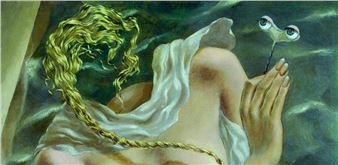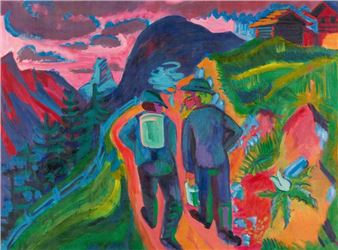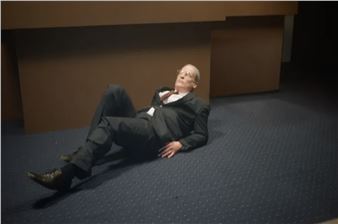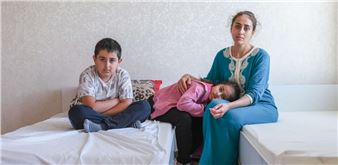Whose Expression? The BrГјcke Artists and Colonialism
The BrГјcke artists lived and worked during a period when Imperial Germany was one of the largest colonial powers in Europe. The exhibition Whose Expression? The BrГјcke Artists and Colonialism examines their works against this historical background.
First and foremost, the exhibition addresses the tension between inspiration and appropriation that characterises the work of Erich Heckel, Ernst Ludwig Kirchner, Emil Nolde, Max Pechstein and Karl Schmidt-Rottluff. On the one hand, the artists identified with the imagined world of the supposedly вҖңnaturalвҖқ cultures of the global South as an antithesis to bourgeois society and sought to overcome the Eurocentrism of their time. On the other hand, they utilised stylistic elements of works from other cultures as inspiration for their art without reflecting on the contexts of the worksвҖҷ creation, colonial power structures, or their own racist world view.
Numerous sketches and paintings attest to the fact that the artists in the ethnological museums in Dresden and Berlin engaged intensively with works from the colonial South. They repeatedly appropriated elements of the Benin bronzes, for example, as well as the Palau beams. Furthermore, they visited theatres, vaudevilles, circuses and racist colonial exhibitions where people were displayed like objects. Some of these colonised people became popular models for the artists.
The exhibition devotes itself to lives of the subjects of these portraits, as well as the histories of the works from the colonial context. For example, the famous leopard stool from KirchnerвҖҷs studio, long thought to be a work by the artist, will be shown for the first time with its significance as a prestige object of CameroonвҖҷs courtly elites and as a testimony to Cameroonian-German colonial history. Another focus will be on the individuals that the BrГјcke artists exoticised as anonymous вҖңothersвҖқ.
The BrГјcke membersвҖҷ encounters with people and works from the colonial context took place predominantly in Germany, for only Nolde and Pechstein travelled to the German colonial territories of Papua New Guinea and Palau. With the aid of photographs, documents such as letters and diaries, and sketches and watercolours created in situ, the exhibition endeavours to trace these journeys. It also addresses the artistsвҖҷ disillusionment when they did not encounter the fantastic paradise of the European imagination on their travels. While travel photographs provide very clear documentation of the colonial occupation, Pechstein and Nolde omitted it from their works.
This exhibition marks the beginning of the өю°щГјіҰ°мұр-ІСіЬІхұріЬіҫвҖҷs confrontation of its colonial legacy. The holdings of the Karl und Emy Schmidt-Rottluff Stiftung still contain around 100 works from the artistвҖҷs estate that originally came from 20 different parts of the world. These will be digitised this year and shared with the public in the open access database Wiki Commons. At the same time as this exhibition, contemporary artists will reflect on the collection in the exhibition Transition Exhibition at the Kunsthaus Dahlem. The preparation of the exhibition and its public programme was accompanied by an internal sensitivity training course for the museumвҖҷs team titled Reflections: Colonial Legacies at the өю°щГјіҰ°мұр-ІСіЬІхұріЬіҫ.

Recommended for you
The BrГјcke artists lived and worked during a period when Imperial Germany was one of the largest colonial powers in Europe. The exhibition Whose Expression? The BrГјcke Artists and Colonialism examines their works against this historical background.
First and foremost, the exhibition addresses the tension between inspiration and appropriation that characterises the work of Erich Heckel, Ernst Ludwig Kirchner, Emil Nolde, Max Pechstein and Karl Schmidt-Rottluff. On the one hand, the artists identified with the imagined world of the supposedly вҖңnaturalвҖқ cultures of the global South as an antithesis to bourgeois society and sought to overcome the Eurocentrism of their time. On the other hand, they utilised stylistic elements of works from other cultures as inspiration for their art without reflecting on the contexts of the worksвҖҷ creation, colonial power structures, or their own racist world view.
Numerous sketches and paintings attest to the fact that the artists in the ethnological museums in Dresden and Berlin engaged intensively with works from the colonial South. They repeatedly appropriated elements of the Benin bronzes, for example, as well as the Palau beams. Furthermore, they visited theatres, vaudevilles, circuses and racist colonial exhibitions where people were displayed like objects. Some of these colonised people became popular models for the artists.
The exhibition devotes itself to lives of the subjects of these portraits, as well as the histories of the works from the colonial context. For example, the famous leopard stool from KirchnerвҖҷs studio, long thought to be a work by the artist, will be shown for the first time with its significance as a prestige object of CameroonвҖҷs courtly elites and as a testimony to Cameroonian-German colonial history. Another focus will be on the individuals that the BrГјcke artists exoticised as anonymous вҖңothersвҖқ.
The BrГјcke membersвҖҷ encounters with people and works from the colonial context took place predominantly in Germany, for only Nolde and Pechstein travelled to the German colonial territories of Papua New Guinea and Palau. With the aid of photographs, documents such as letters and diaries, and sketches and watercolours created in situ, the exhibition endeavours to trace these journeys. It also addresses the artistsвҖҷ disillusionment when they did not encounter the fantastic paradise of the European imagination on their travels. While travel photographs provide very clear documentation of the colonial occupation, Pechstein and Nolde omitted it from their works.
This exhibition marks the beginning of the өю°щГјіҰ°мұр-ІСіЬІхұріЬіҫвҖҷs confrontation of its colonial legacy. The holdings of the Karl und Emy Schmidt-Rottluff Stiftung still contain around 100 works from the artistвҖҷs estate that originally came from 20 different parts of the world. These will be digitised this year and shared with the public in the open access database Wiki Commons. At the same time as this exhibition, contemporary artists will reflect on the collection in the exhibition Transition Exhibition at the Kunsthaus Dahlem. The preparation of the exhibition and its public programme was accompanied by an internal sensitivity training course for the museumвҖҷs team titled Reflections: Colonial Legacies at the өю°щГјіҰ°мұр-ІСіЬІхұріЬіҫ.
Artists on show
Contact details

Related articles
In the early 20th century, artists like Emil Nolde and Max Pechstein searched for "primitive authenticity" in the German colonies. Here's what they found.
After a few decades of the rigorous development of postcolonial theory and decoloniality in the academy, efforts to decolonize museums and cultural institutions were only really initiated in the last half decade.

 ARTISTS
ARTISTS















